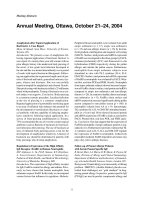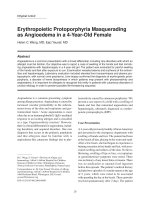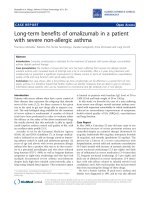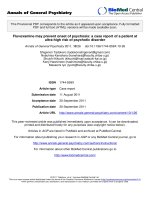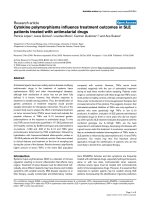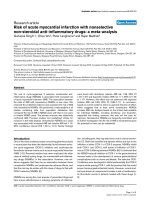Báo cáo y học: " Tenecteplase for ST-elevation myocardial infarction in a patient treated with drotrecogin alfa (activated) for severe sepsis: a case report" pot
Bạn đang xem bản rút gọn của tài liệu. Xem và tải ngay bản đầy đủ của tài liệu tại đây (1.12 MB, 5 trang )
BioMed Central
Open Access
Page 1 of 5
(page number not for citation purposes)
Journal of Medical Case Reports
Case report
Tenecteplase for ST-elevation myocardial infarction in a
patient treated with drotrecogin alfa (activated) for severe sepsis: a
case report
Lillian Barra
1
, Jeffrey Shum
1
, J Geoffrey Pickering
2
and Raymond Kao*
1
Address:
1
Division of Critical Care, Department of Medicine, University of Western Ontario, Commissioner's Rd, London, Ontario, Canada and
2
Division of Cardiology, Department of Medicine, University of Western Ontario, Commissioner's Rd, London, Ontario, Canada
Email: Lillian Barra - ; Jeffrey Shum - ; J Geoffrey ;
Raymond Kao* -
* Corresponding author
Abstract
Introduction: Drotrecogin alfa (activated) (DrotAA), an activated protein C, promotes
fibrinolysis in patients with severe sepsis. There are no reported cases or studies that address the
diagnosis and treatment of myocardial infarction in septic patients treated with DrotAA.
Case presentation: A 59-year-old Caucasian man with septic shock secondary to community-
acquired pneumonia treated with DrotAA, subsequently developed an ST-elevation myocardial
infarction 12 hours after starting DrotAA. DrotAA was stopped and the patient was given
tenecteplase thrombolysis resulting in complete resolution of ST-elevation and no adverse bleeding
events. DrotAA was restarted to complete the 96-hour course. The sepsis resolved and the patient
was discharged from hospital.
Conclusion: In patients with severe sepsis or septic shock complicated by myocardial infarction,
it is difficult to determine if the myocardial infarction is an isolated event or caused by the sepsis
process. The efficacy and safety of tenecteplase thrombolysis in septic patients treated with
DrotAA need further study.
Introduction
Sepsis with multi-organ failure has a high incidence and a
mortality rate of 30-50% [1]. The pathophysiology of sep-
sis is an inflammatory and procoagulant state triggered by
infection. Activated protein C (APC) plays an important
role by promoting fibrinolysis and inhibiting thrombosis
and inflammation. The PROWESS trial reported a 6.1%
absolute reduction in 28-day mortality for septic patients
treated with drotrecogin alfa (activated) (DrotAA) [2].
Subsequent studies and subanalyses have suggested that
most of the benefit is seen in patients with high illness
severity scores or multiple organ dysfunction [3]. In our
center, patients are treated with DrotAA (24 mcg/kg/hour
× 96 hours) when there is evidence of infection, signs of
systemic inflammatory response syndrome plus two or
more organ system failures or one organ system failure
and APACHE II score ≥25. Patients are excluded if death is
perceived to be imminent, sepsis-induced organ failure
has lasted more than 48 hours or there is an increased risk
of life-threatening or intracranial bleeding.
Published: 5 November 2009
Journal of Medical Case Reports 2009, 3:109 doi:10.1186/1752-1947-3-109
Received: 7 August 2008
Accepted: 5 November 2009
This article is available from: />© 2009 Barra et al; licensee BioMed Central Ltd.
This is an Open Access article distributed under the terms of the Creative Commons Attribution License ( />),
which permits unrestricted use, distribution, and reproduction in any medium, provided the original work is properly cited.
Journal of Medical Case Reports 2009, 3:109 />Page 2 of 5
(page number not for citation purposes)
Case presentation
A 59-year-old Caucasian man presented to the emergency
department after a motor vehicle collision and was found
to have a right lower lobe pneumonia but no other inju-
ries. He was discharged home on azithromycin. He had a
history of type 2 diabetes, asthma, hypertension and
hyperlipidemia, but he was a non-smoker with a negative
history for coronary heart disease or strokes. His medica-
tion included ventolin, glyburide, metformin, quinipril,
atorvastatin and aspirin. Two days later, he presented to
the same emergency department with a decreased level of
consciousness and respiratory distress, requiring mechan-
ical ventilation and transfer to the intensive care unit
(ICU).
On admission, he was hemodynamically stable and his
temperature was 39.2°C. His white blood cell count was
11.3 × 10
9
/L, hemoglobin 131 g/L and platelets 150 ×
10
9
/L. Arterial blood gas showed a PaO
2
97 mmHg on
100% oxygen, PaCO
2
54 mmHg, bicarbonate 25 mmol/L
and pH 7.32. His lactate level was 2.1 mmol/L, SvO
2
76%
and troponin I was elevated at 0.6 μg/L. His international
normalized ratio (INR), partial thromboplastin time
(PTT), liver enzymes and electrolytes were normal, but
creatinine was elevated at 211 μmmol/L. His chest X-ray
demonstrated worsening of pneumonia and his electro-
cardiogram (ECG) showed no evidence of ischemia. Intra-
venous antibiotics (cefotaxime) were given pending
microbiological culture results.
Four hours after presentation, his mean arterial pressure
(MAP) decreased from 77 mmHg to 60 mmHg and he was
unresponsive to fluid resuscitation alone. There were no
ischemic changes on ECG monitoring and further tro-
ponin I testing was not performed. The rest of the labora-
tory tests were unchanged. It was felt that the patient had
developed severe sepsis secondary to community-
acquired pneumonia and norepinephrine plus vaso-
pressin (0.4 U/minute) were initiated for blood pressure
support. His APACHE score was 26, and with two dys-
functional organs, DrotAA and hydrocortisone were initi-
ated as part of severe sepsis treatment.
Twelve hours after starting DrotAA, the patient was noted
to have ST-elevations on the cardiac monitor and the ECG
demonstrated 2-3 mm ST-segment elevations in the infer-
olateral leads (Figure 1A). The troponin I level was ele-
vated to 98.89 μg/L. Immediate primary percutaneous
coronary intervention was not available at the hospital, so
tenecteplase (TNK; 40 mg intravenous bolus) was admin-
istered followed by intravenous heparin titrated by a
nomogram to maintain a PTT of 60-80 seconds for a total
of 4 hours. The DrotAA infusion was stopped 4 hours
before initiating TNK because of the theoretical risk of
increased bleeding by combining it with TNK. Similarly,
other than aspirin, no other antiplatelet agents were used.
There was acceptable resolution of the ST-segment eleva-
tion by 1.5 hours post TNK administration (Figure 1B, C).
The DrotAA infusion was restarted 8 hours post TNK treat-
ment for a total of 96 hours. An echocardiogram obtained
24 hours after the event demonstrated severe global hypo-
kinesis of the left ventricle with an ejection fraction (EF)
of 20-25% and reduced right ventricular function.
In the 24 hours following TNK, the patient's blood pres-
sure improved and he no longer required norepinephrine
and vasopressin. His blood cultures grew Streptococcus
pneumoniae sensitive to cefotaxime and azithromycin. On
day 5 of admission, the patient was extubated and trans-
ferred out of the ICU. Cardiac catheterization was per-
formed (Figure 2) and demonstrated insignificant
irregularities of the right coronary artery and a normal left
anterior descending artery. There was an irregularity in the
left circumflex artery that could have been the remnants of
the culprit lesion. The EF was 45% with akinesis of a seg-
ment of the posterolateral and inferior wall. The patient
was subsequently discharged home on day 12 after admis-
sion.
Discussion
Myocardial dysfunction is a common complication in
patients with severe sepsis with approximately 50% of
patients having impairment of ventricular systolic func-
tion. The mechanism for the dysfunction is via incom-
pletely characterized depressant mediators [4]. The
relationship between elevated cardiac troponin levels and
a diagnosis of myocardial infarction due to thrombosis is
uncertain in the ICU setting. Ammann et al. [5] revealed
that more than 70% of ICU patients with elevated cardiac
troponin levels did not have flow-limiting coronary artery
disease as indicated by stress echocardiography or by find-
ings at autopsy.
The significance of the ST-segment elevation in patients
with sepsis is also questioned. Several published reports
indicate that acute ST-segment elevations can occur in sep-
sis with non-significant coronary artery disease [6]. There-
fore the ECG changes should be considered in relation to
the clinical data at presentation, rather than interpreted as
a single diagnostic finding. Assessment for symptoms of
ischemia in intubated patients is limited, but recognizing
myocardial infarction in these patients is important as it
may contribute to increased morbidity and mortality [7].
Certain medications used uniquely in ICU settings may
also contribute to ischemic events. Holmes et al. [8] found
an increase in cardiac arrests in ICU patients on doses of
vasopressin greater than 0.05 U/minute.
APC inhibits coagulation by inactivating factor Va and
VIIIa and promotes fibrinolysis by inhibition of type 1
Journal of Medical Case Reports 2009, 3:109 />Page 3 of 5
(page number not for citation purposes)
Electrocardiogram response to tenecteplase lysisFigure 1
Electrocardiogram response to tenecteplase lysis. (A) Electrocardiogram before tenecteplase thrombolysis; 2 mm ST-
elevations in leads in I, II, III, aVF and 3 mm ST-elevations in V5, V6. (B) Two hours post-tenecteplase; 50% decrease in ST-ele-
vations. (C) Twenty-four hours post-tenecteplase; complete resolution of ST-elevations.
B
A
C
Journal of Medical Case Reports 2009, 3:109 />Page 4 of 5
(page number not for citation purposes)
plasminogen activator inhibitor (PAI-1). Animal models
suggest that APC enhances thrombolysis and prevents re-
occlusion in coronary artery thrombosis [9,10]. A small
randomized controlled trial investigating the addition of
DrotAA versus unfractionated intravenous heparin with
tissue plasminogen activator in patients with ST-elevation
myocardial infarction (STEMI) found that the DrotAA
group had lower levels of PAI-1. The authors concluded
that DrotAA may be beneficial in the treatment of acute
myocardial infarction, however the study lacked clinical
outcomes and the numbers were too small to make any
meaningful conclusion regarding the use of DrotAA in
STEMI or for prevention of thrombotic events [11].
To the best of our knowledge, our patient is the first
reported case of severe sepsis treated with TNK while on
DrotAA for STEMI. The differential diagnosis includes
streptococcal myocarditis and stress-induced Takotsubo
cardiomyopathy with clinical presentations indistinguish-
able from myocardial infarction. For patients with myo-
carditis, a definitive diagnosis cannot be made without
tissue biopsy and cultures. Takotsubo cardiomyopathy
will typically have ST-elevation in the precordial leads,
mild to modest elevations in cardiac troponins, hypokine-
sis of the mid to apical segments of the left ventricle and
no critical lesions on cardiac angiogram [12]. Takotsubo
has been described with Streptococcus pneumoniae infec-
tions, as seen in this patient [13]. However, our patient
had an inferolateral distribution of ischemia with a
marked elevation in troponin I and global hypokinesis,
which is atypical for Takotsubo cardiomyopathy.
Our patient with severe sepsis was found to have ST-eleva-
tions on ECG, a large troponin rise and global cardiac
Ventriculogram and coronary angiogram day 9 post ST-elevation myocardial infarctionFigure 2
Ventriculogram and coronary angiogram day 9 post ST-elevation myocardial infarction. (A, B) Ventriculogram
(left anterior oblique view) in diastole (A) and systole (B). (C) Tracings of ventricular wall in diastole (white) and systole (yel-
low); minimal contraction of posterolateral wall (arrow) indicative of akinesis. (D) Left anterior oblique view of right coronary
artery with insignificant irregularities. (E) Right anterior oblique view of left coronary system; normal left anterior descending
artery, irregularities of left circumflex artery shown in detail in (F).
AB
D
EF
C
Journal of Medical Case Reports 2009, 3:109 />Page 5 of 5
(page number not for citation purposes)
hypokinesis. Given that our center did not have access to
urgent cardiac catheterization, we elected to treat him as a
STEMI patient with the accepted standard of TNK throm-
bolysis followed by heparin infusion. DrotAA was
stopped because of the increased risk of bleeding and then
resumed for ongoing sepsis 8 hours after the thromboly-
sis. The patient had resolution of ST-elevations post-
thrombolysis with improvement in cardiac function as
well as resolution of sepsis with no adverse bleeding
events.
A cardiac angiogram performed post-thrombolysis
revealed mild irregularities and no coronary artery occlu-
sion, suggesting a non-thrombotic cause for his cardiac
event. However, the findings could also reflect successful
thrombolysis. This is supported by evidence of posterola-
teral and inferior wall hypokinesis with left circumflex
artery irregularity, corresponding to the initial ECG ST-ele-
vation territory. The global hypokinesis seen on echocar-
diogram before cardiac catheterization may have been
due to a combination of sepsis-induced myocardial dys-
function and a possible ischemic event. Unfortunately,
without primary cardiac catheterization, we cannot defin-
itively know whether our patient's cardiac dysfunction
was secondary to a thrombotic mechanism versus induced
by sepsis.
Conclusion
Further research is needed on the prognostic significance
of elevated cardiac troponins and ST-elevation as well as
their relationship to myocardial infarction in critically ill
patients. A guideline is also needed to advise treatment
strategies in septic patients who develop STEMI/non-
STEMI while being treated with other fibrinolytic agents
not approved for myocardial infarction such as DrotAA.
Abbreviations
APC: activated protein C; DrotAA: drotrecogin alfa (acti-
vated); ECG: electrocardiogram; EF: ejection fraction;
ICU: intensive care unit; INR: international normalized
ratio; MAP: mean arterial pressure; PTT: partial thrombo-
plastin time; STEMI: ST-elevation myocardial infarction;
TNK: tenecteplase
Consent
Written informed consent was obtained from the patient
for publication of this case report and any accompanying
images. A copy of the written consent is available for
review by the Editor-in-Chief of this journal.
Competing interests
The authors declare that they have no competing interests.
Authors' contributions
LB collected and analyzed all patient data, conducted a lit-
erature review and was a major contributor in writing the
manuscript. JS collected and analyzed data related to the
patient's stay in the intensive care unit. JGP collected,
interpreted and analyzed data related to cardiac investiga-
tion. RK analyzed all data pertinent to the case, conducted
a literature review and was a major contributor in writing
the manuscript. All authors read and approved the final
manuscript.
References
1. Rangel-Frausto MS, Pittet D, Costigan M, Hwang T, Davis CS, Wenzel
RP: The natural history of the systemic inflammatory
response syndrome (SIRS): a prospective study. JAMA 1995,
273:117-123.
2. Bernard GR, Vincent J, Laterre P, LaRosa SP, Dhainaut JF, Lopez-Rod-
riguez A, Steingrub JS, Garber GE, Helterbrand JD, Ely EW, Fisher C:
Efficacy and safety of recombinant Activated Protein C for
severe sepsis. N Engl J Med 2001, 344:699-709.
3. Wiedermann CJ, Kaneider NC: A meta-analysis of controlled tri-
als of recombinant human activated protein C therapy in
patients with sepsis. BMC Emerg Med 2005, 5:7.
4. Krishnagopalan S, Kumar A, Parrillo JE, Kumar A: Myocardial dys-
function in the patient with sepsis. Curr Opin Crit Care 2002,
8:376-388.
5. Ammann P, Maggiorini M, Bertel O, Haenseler E, Joller-Jemelka HI,
Oechslin E, Minder EI, Rickli H, Fehr T: Troponin as risk factor for
mortality in critically ill patients without acute coronary syn-
dromes. J Am Coll Cardiol 2003, 41:2004-2009.
6. Terradellas JB, Bellot JF, Saris AB, Gil CL, Torrallardona AT, Garriga
JR: Acute and transient ST segment elevation during bacte-
rial shock in seven patients without apparent heart disease.
Chest 1982, 81:444-448.
7. Relos RP, Hasinoff IK, Beilman GJ: Moderately elevated serum
troponin concentrations are associated with increased mor-
bidity and mortality rates in surgical intensive care unit
patients. Crit Care Med 2003, 31:2598-2603.
8. Holmes CL, Walley KR, Chittock DR, Lehman T, Russell JA: The
effects of vasopressin on hemodynamics and renal function
in severe septic shock: a case series. Intensive Care Med 2001,
27:1416-1421.
9. Hashimoto M, Yamashita T, Oiwa K, Watanabe S, Giddings JC,
Yamamoto J: Enhancement of endogenous plasminogen acti-
vator-induced thrombolysis by argatroban and APC and its
control by TAFI, measured in an arterial thrombolysis
model in vivo using rat mesenteric arterioles. Thromb Haemost
2002, 87:110-113.
10. Sakamoto T, Ogawa H, Yasue H, Oda Y, Kitajima S, Tsumoto K,
Mizokami H:
Prevention of arterial reocclusion after throm-
bolysis with activated protein C: Comparison with heparin in
a canine model of coronary artery thrombosis. Circulation
1994, 90:427-432.
11. Sakamoto T, Ogawa H, Takazoe K, Yoshimura M, Shimomura H,
Moriyama Y, Arai H, Okajima K: Effect of activated protein C on
plasma plasminogen activator inhibitor activity in patients
with acute myocardial infarction treated with alteplase. J Am
Coll Cardiol 2003, 42:1389-1394.
12. Prasa A, Lerman A, Rihal CS: Apical ballooning syndrome (Tako-
Tsubo or stress cardiomyopathy): a mimic of acute myocar-
dial infarction). Am Heart J 2007, 155:408-416.
13. Geng S, Mullany D, Fraser JF: Takotsubo cardiomyopathy associ-
ated with sepsis due to Streptococcus pneumoniae pneumo-
nia. Crit Care Resusc 2008, 10:231-234.


